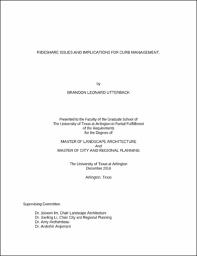| dc.description.abstract | As autonomous vehicles continue to prove themselves on our roads today, a look at the considerations of implementation will be necessary. The potential for rethinking our infrastructure requirements, as a result of this new technology, could be a significant benefit to everyday life in terms of safety, congestion, and travel behavior. We must also consider the potential impact on the environment, which is often overlooked. If automobile infrastructure such as roads and parking lots are reduced in urban areas, how will this rediscovered urban space be used? How will planners, designers, and policymakers adapt our infrastructure needs when less pressure is put on parking, and more pressure is felt at the curb, sidewalk, and doorstep?
Autonomous and rideshare technologies will replace the need for a commuter to visit a parking lot only to leave a car behind. Autonomous vehicles will park themselves, and point-to-point ride share enables riders to be dropped off much closer to their desired destinations. The literature indicates that we are beginning to see the need for an alternative type of infrastructure to support this desire. Currently, rideshare pickups and drop-offs are causing issues in congestion and safety, as this transaction typically occurs in areas not yet designed for passenger exchange. However, drivers are left with limited alternatives as riders demand to be dropped off in places that are most convenient for them. Therefore, drivers are likely to take the risk and/or break the law in order to accommodate a rider’s desire. These issues may continue to increase as millennials choose to give up their cars, and Mobility as a Service (MaaS) gains popularity.
Research methods adopted for this study were quantitative and qualitative in nature. Observational studies provided data on the current interface between people and automobiles at various types of arrival and departure points. This led to an understanding and recommendations on alterations to associated transportation infrastructure, with an emphasis on exploring efficiency, and safety in drop-off and pickup of passengers.
Recommendations from this research look to aid decision-makers at UTA and beyond in transitioning from the current infrastructure centered around the parked car, to a new infrastructure. Lessons learned from the data collected in observation and survey data provided insight into where and how rideshare occurred, as well as insight into considerations of safety, traffic, preference, comfort, and use of current and the potential of future alterations to accommodate a new type of rideshare infrastructure.
The findings of this study can also be applied to scenarios outside of UTA as those entities look to accommodate rideshare exchange infrastructure solutions of their own. Whether cars park themselves or drivers drop riders off at the curb, the need for riders to visit parking will likely decrease, and the need to accommodate rideshare pick-up and drop-offs will only increase. The sooner that policy and decision-makers assess these needs and make proactive and transitional changes the better. A look toward the curb and away from the parking lot could not only save space and money, it could do so in a way that makes our lives safer, more convenient, and in a more environmentally responsible way. | |


